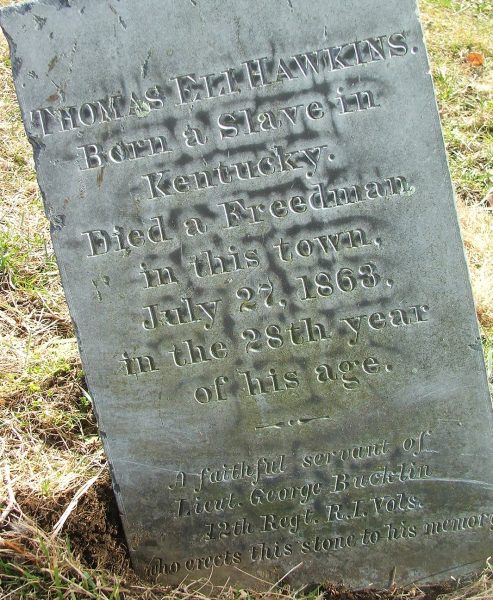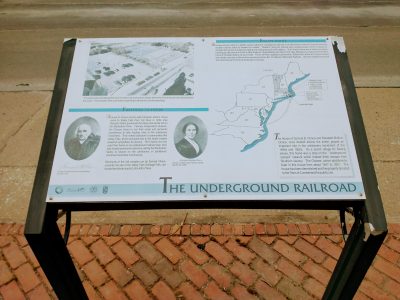Black History Month – Some Places to Explore in the Valley

Blackstone Valley Culinaria News
January 27, 2022
Valentine Round Up for Blackstone Valley, RI
February 7, 2022Black History Month – Some Places to Explore in the Valley
The roadside guide, “On The Rhode to Freedom,” created by the nonprofit group Stages of Freedom, recommends many sites associated with African-American History to visit in Rhode Island, including several in the Blackstone Valley.
Here are just a sampling of a few of the Blackstone Valley sites:
- Woonsocket – Woonsocket City Hall, Cato Hill Historic District
- Cumberland – Underground Railroad Site, 45 Broad Street
- Central Falls – Again associated with Elizabeth Buffum Chace and her family home on Broad Street
- East Providence – Newman Cemetery, corner of Newman Avenue & Pawtucket Avenue, Rumford
Sites in Valley Falls
Let’s take a closer look at these sites. First stop, Central Falls and Cumberland in the area known as Valley Falls. This is the place where the Elizabeth Buffum Chace family home was located on Broad Street where she hosted Frederick Douglass, Sojourner Truth, Abby Kelly and other abolitionists. At the age of 85, Chace wrote a memoir entitled ‘Anti-slavery Reminiscences” and in it she writes:
“After coming to Rhode Island (she had married Samuel Chace and had been living in Fall River), our house became the resting place for advocates of freedom for the slave, when travelling, or lecturing in this region, until the fetters which bound him were broken.”
She also states that she was born and baptized into the anti-slavery spirit as she reminisces about growing up in a family that were Quaker abolitionists, including how her grandfather, William Buffum often let his homestead in Smithfield, RI serve as a refuge for a family of fugitive slaves.
Later she and her husband, Samuel Chace, opened up their home in Cumberland as part of the Underground Railroad. Samuel Chace had come to Valley Falls to take over the operation of the Valley Falls Manufacturing Company from his father. Today there is a park on the site of the mill, the Valley Falls Heritage Park on Broad Street in Cumberland, that one may visit to learn more about the mill and a little bit about the family. The home at 45 Broad Street served as a preeminent spot along the Underground Railroad. Though the house no longer remains, there is a historical marker located just north of Town Hall. MORE INFO
Read more about Elizabeth-Buffum Chace’s “Anti-Slavery Reminiscences”
East Providence
Newman Cemetery, East Providence – Located in Rumford Village, the Newman Cemetery features the grave sites of two African-Americans, Thomas Eli Hawkins and Anna Bowen.
On Hawkins’ burial it reads ” Born a slave in Kentucky. Died a Freedman in this town, July 27, 1863 in the 28th year of his Age. A faithful Servant of Lieut. George Bucklin. 12th Regt. R.I. Vols. Who erects this stone to his memory.”
Bowen’s reads, “A Negro Servant to Col. Jabez Bowen.” “Aged about 80 years.” “Thou a good master I was a good slave, I now rest from labor & sleep in my grave.”

From Newman Cemetery head to HeART Spot Art Gallery, 1970 Pawtucket Avenue, for its Black History Month Art Exhibit opening Saturday, February 5 with an Artist Reception on Saturday, February 12 from 6 – 8 pm.
Though the physical museum is in transition, you might also want to visit the Cape Verdean Museum website. It is the nation’s only museum dedicated to Cape Verdean history.
Sites in Woonsocket
Now let’s head North to Woonsocket and the sites mentioned in “On The Rhode to Freedom,” beginning with Woonsocket City Hall at 169 Main Street where Edward Harris, a successful industrialist and abolitionist, hosted Abraham Lincoln on his second visit to Rhode Island in 1860.
Harris constructed the earliest part of the building in 1856 then known as Harris Institute, which served as the first public library in Rhode Island. It was in Harris Hall, then one of the largest assembly rooms in the state, that Lincoln spoke to a packed crowd.
If you continue further to Main Street at Rt. 122 to the Woonsocket Depot, you will find in front of the depot a silhouetted sculpture of Abraham Lincoln, which was installed in 2019 to commemorate the 159th anniversary of Lincoln’s visit to the city. Lincoln arrived in Woonsocket by train on March 8, 1860 as the top Republican Presidential candidate. His political platform was abolition of slavery. After Lincoln spoke, he was a guest at Harris’s estate located on Harris Ave (Route 122) and Blackstone Street not too far from Cold Spring Park.
Another site in Woonsocket, mentioned in the Rhode to Freedom, is the Cato Hill Historic District at Cato Street. From Cold Spring Park turn right onto Harris Ave and left onto Blackstone Street to Arnold and Cato Street at Church Street. The district is named for Cato Willard, husband of African-American Lydia Brayton Willard. Lydia was descended from Prince Aldrich, one of two slaves owned by Samuel Aldrich of Smithfield. Prince Aldrich purchased the land upon his freedom which passed on to Lydia. Her husband laid out Cato Street and she platted new lots at Church & Cato Street. The neighborhood was placed on the National Historic Register in 1976.
From Cato Hill head Southeast along Main Street to Market Square and turn onto South Main Street. At the corner of Mason Street you may visit the MLK Memorial Sculpture Garden created by Riverzedge Arts in 2012.
For more sites in the Blackstone Valley and Rhode Island check out Stages of Freedom’s On The Rhode To Freedom.
We recommend checking out these sites and taking in the surrounding landscape and historic architecture during Black History Month or whenever you find yourself in the area.

